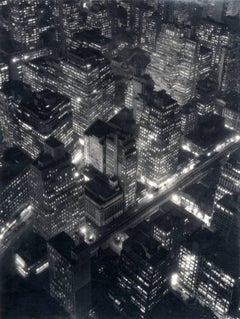Berenice Abbott On Sale
Recent Sales
1930s American Modern Black and White Photography
Silver Gelatin
Berenice Abbott, 1898-1991 for sale on 1stDibs
While photographer Berenice Abbott has wrongly never been heralded as one of the defining giants of 20th-century photography, she is widely known, indeed celebrated, for her iconic portraits of some of the most glamorous denizens of 1920s bohemian Paris.
And although less familiar, Abbott’s photos of the deserted streets, aging tenements and rising office towers of Depression-era New York have been critically recognized as nothing short of groundbreaking. Additionally, her relatively obscure work as a science photographer has received an admiring reappraisal in recent years. Recognized for having dramatically advanced the medium’s aesthetics and techniques (earning four patents along the way), not to mention the ambition of her subject matter — the principle laws of physics — she has been favorably compared to two early masters of modernist experimentation: her mentor Man Ray and László Moholy Nagy.
In 1918, at just 19, freckled, androgynous and with cropped hair, Abbott fell in with a crowd that included the lesbian writer and illustrator Djuna Barnes and the Dadaists Man Ray and Marcel Duchamp. They encouraged her to follow them to Paris and study with the renowned sculptor Antoine Bourdelle. Unable to pay for her training, and barely surviving, Abbott took a job as Man Ray’s assistant. The miracles of the darkroom quickly converted her to photography, as did her paycheck, and Man Ray tutored her in its fundamentals.
By 1926, Abbott had set up her own studio with backing from Peggy Guggenheim, the American heiress and art patron. André Gide, Jean Cocteau, Janet Flanner and James Joyce were among the luminaries and socialites who came for sittings. Her subversive lens made for riveting portraits.
A number of Abbott’s images of New York appear to have been shot by drone or, in the technological equivalent for the day, a dirigible. They actually entailed her stationing herself precariously on the rooftops and ledges of the skyscrapers along Wall Street and Midtown.
That feat recalls the famous photograph of Abbott’s contemporary and fellow Ohioan Margaret Bourke-White taking a shot of the New York skyline astride one of the metallic eagle heads atop the Chrysler building. One can only wonder if a photograph of Abbott in a similarly heroic pose would have helped her recognition as the trailblazing documentarian she was.
Find Berenice Abbott photography on 1stDibs.
Finding the Right black-white-photography for You
There’s a lot to love about black and white photography.
The unique and timeless quality of a black and white photograph accentuates any room. Some might argue that we’re naturally drawn to color photography because it’s the world we know best. This is a shared belief, particularly in the era of camera-phone photography, editing apps and the frenetic immediacy of sharing photos on social media. But when we look at black and white photography, we experience deep, rich shadows and tonal properties in a way that transfixes us. Composition and textures are crisp and engaging. We’re immediately drawn to the subjects of vintage street photography and continue to feel the emotional impact of decades-old photojournalism. The silhouettes of mountains in black and white landscape photography are particularly pronounced, while portrait photography and the skylines of urban cityscapes come to life in monochrome prints.
When decorating with fine photography, keep in mind that some color photographs may not be suitable for every space. However, you can be more daring with black and white photos. The gray tones are classic, sophisticated and generally introduce elegance to any corner of your home, which renders black and white prints amazingly versatile.
Black and white photography adapts to its surroundings like a chameleon might. A single large-scale black and white photograph above the sofa in your living room is going to work with any furniture style, and as some homeowners and designers today are working to introduce more muted tones and neutral palettes to dining rooms and bedrooms, the integration of black and white photography — a hallmark of minimalist decor — is a particularly natural choice for such a setting.
Another advantage to bringing black and white photography into your home is that you can style walls and add depth and character without worrying about disrupting an existing color scheme. Black and white photographs actually harmonize well with accent colors such as yellow, red and green. Your provocative Memphis Group lighting and bold Pierre Paulin seating will pair nicely with the black and white fine nude photography you’ve curated over the years.
Black and white photography also complements a variety of other art. Black and white photos pair well with drawings and etchings in monochromatic hues. They can also form part of specific color schemes. For example, you can place black and white prints in colored picture frames for a pop of color. And while there are no hard and fast rules, it’s best to keep black and white prints separate from color photographs. Color prints stand out in a room more than black and white prints do. Pairing them may detract attention from your black and white photography. Instead, dedicate separate walls or spaces to each.
Once you’ve selected the photography that best fits your space, you’ll need to decide how to hang the images. If you want to hang multiple photos, it’s essential to know how to arrange wall art. A proper arrangement can significantly enhance a living space.
On 1stDibs, explore a vast collection of compelling black and white photography by artists such as Mark Shaw, Jack Mitchell (a photographer you should know), Berenice Abbott and David Yarrow.
